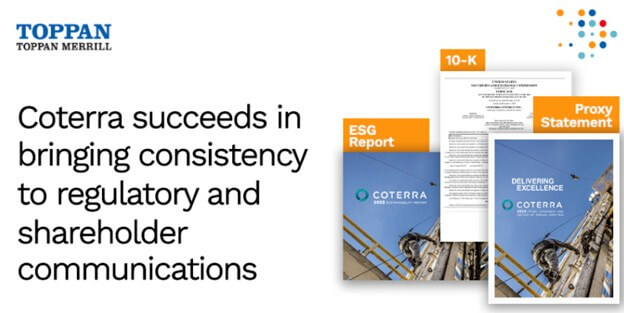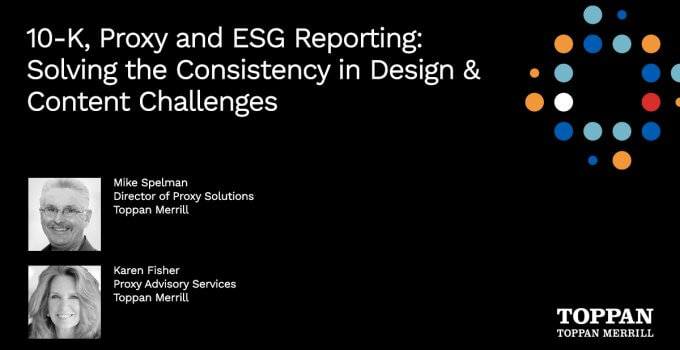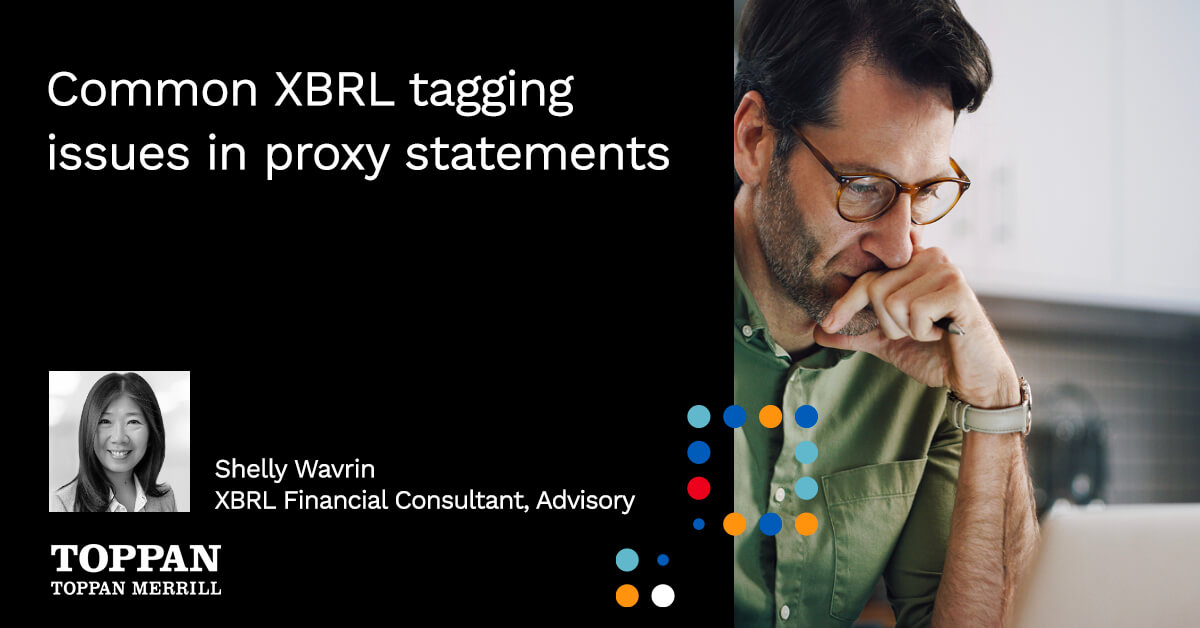Company 10-K, Proxy and ESG or sustainability reports should tell a consistent story, including material disclosures, where applicable, and present that information in a comprehensive and understandable way (both in a language and visual design perspective). These documents serve as vital tools for engaging all stakeholders and inconsistencies can have a significant impact both from a regulatory and reputation perspective.
The increasing importance of ESG or sustainability reporting brings in a new set of considerations around materiality, as well as new stakeholders in the reporting process — magnifying the need for (and the challenge of) consistency across all company mandated and voluntary reporting. Let’s dive into why consistency matters, where companies struggle most and how expert financial reporting partners are helping companies achieve harmony and efficiency in all aspects of financial reporting.
The regulatory and reputational costs of reporting inconsistencies
From a regulatory standpoint, consistency in messaging and disclosures across reports is critical. Inconsistencies can attract SEC scrutiny that no company wants. Moreover, watchdog groups like ISS and Glass Lewis closely monitor these reports for conflicting information. When they find them, they raise the red flag — potentially impacting a director’s election or possibly a failed approval vote of the organization’s growth or expansion prospects.
On a more general level, flagged contradictory data raises overarching concerns around the validity of all reporting data, as well as governance concerns about the controls around company processes, policies and reporting.
The consistency challenge
Developing and writing these documents makes consistency an inherent challenge for most companies. Producing the three main types of reports – the 10-K, Proxy and ESG or sustainability report — requires input from numerous departments or teams, including legal, finance, marketing, HR, IT, operations and investor relations. This multi-departmental involvement commonly creates variability in content and presentation.
ESG adds new wrinkles to reporting consistency
As ESG or sustainability reports move from a voluntary to regulatory requirement in more jurisdictions, many companies are still navigating this new frontier. As compared to the traditional 10-K and Proxy reports, there are few examples of clear-cut definitions of materiality or best practices for how to present ESG information.
Moreover, while the purpose of the ESG or sustainability report remains distinct from the 10-K and Proxy, information deemed material to the ESG report increasingly becomes material to the other two reports.
Common gaps in reporting consistency
The presentation of data is the first source of reporting inconsistency — and it’s a particular issue with ESG data. For example, charts, graphs and other visualizations used to illustrate metrics for climate-related data, human capital or board diversity should present the same information, when deemed material, in the Annual Report as disclosed in the ESG report.
Missing data from report to report is an even bigger issue. Data identified as material to a specific business concern in one report may not be included in discussions of that same business concern in another report. If an ESG report discusses material environmental or governance issues, this information should also be disclosed in the appropriate SEC filed report, e.g., 10-K and/or Proxy, as it is material to investors’ decision-making processes.
Looking to expert partners to drive consistency and efficiency in report creation
A key underlying issue is that reporting processes often are led by individuals for whom legal and financial reporting is just one of many hats they wear or responsibilities they juggle. They do not have the luxury of time or in some cases, the experienced eye to look for and correct inconsistencies.
To address this fundamental challenge, companies are increasingly turning to external partners like Toppan Merrill. Leaning on an external partner delivers several benefits:
- Capacity: Using an external partner resolves the challenge of finding the time to create and execute consistency-control processes in-house.
- Objective perspective: An external partner provides a fresh, unbiased view, helping to identify inconsistencies where internal teams might otherwise overlook.
- Design & brand insights: Most companies do not have the in-house resources to fully create and apply design to their financial reports. External partners have dedicated design and content creation teams that specialize in this exact area.
- Stakeholder coordination: An external partner can take on the time-consuming task of coordinating communications and ensuring continuous alignment between multiple stakeholders, providing input for each individual report.
- Experience-driven expertise: External partners bring a much deeper well of experience. This typically drives a more holistic and systematic approach to ensuring that the 10-K, Proxy and ESG reports are not only compliant, but clear, consistent and compelling in their messaging and design.
Case studies in consistency
Coterra + Toppan Merrill: Coterra initially engaged Toppan Merrill to assist with their Proxy report. During initial conversations, information gaps and inconsistent reporting issues were identified. Once these issues were brought to the attention of Coterra’s reporting team, they engaged Toppan Merrill to address our findings across their published reports. Through a systematic approach centered on regular calls with all parties, the Toppan Merrill project team created alignment that enhanced both the design and content consistency of Coterra’s reports.
See how they did it. View Coterra’s 2024 10-K, Proxy and ESG Reports here

Essent Group + Toppan Merrill: Essent Group initially approached Toppan Merrill for help in refreshing its proxy materials. When the company’s ESG report was discussed on the first intake call, our team asked discovery questions that helped the company recognize the need to improve consistency across not only the Proxy and ESG report; but its Form 10-K. Essent Group engaged Toppan Merrill to create a new design that incorporated their current brand elements and consistent messaging across all three reports.
Driving business value through consistent reporting
As the complexities of corporate reporting grow, the process of generating the 10-K, Proxy and ESG or sustainability reports involves more internal parties and more complicated considerations. Companies must be aware of the regulatory and reputational risks of allowing inconsistencies to be exposed across their regulatory and voluntary reporting. Engaging an external subject matter expert partner to support the company’s desire to achieve consistency is often a value-added business decision.
By bringing in the expertise of a partner like Toppan Merrill, companies can significantly reduce the internal time and costs of generating these reports, freeing staff to focus on their core responsibilities. At the same time, partners like Toppan Merrill can help companies relay more consistent and compelling information and data to shareholders and other stakeholders through these reporting documents — fostering greater support to drive business growth.
Learn more about our ESG, Proxy and SEC reporting solutions.


